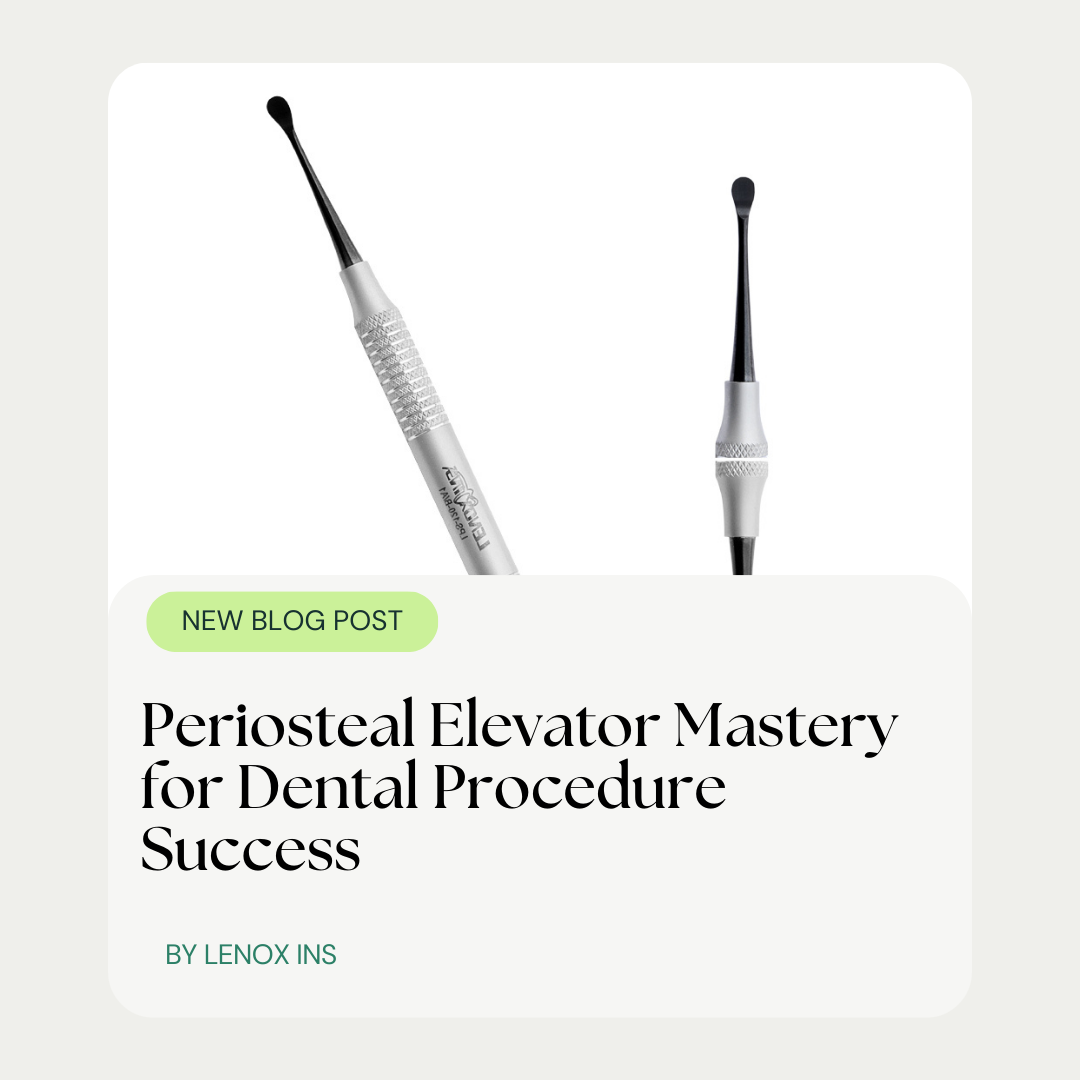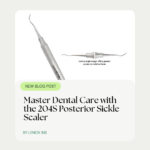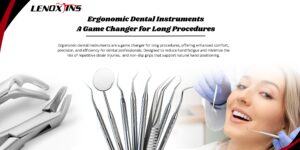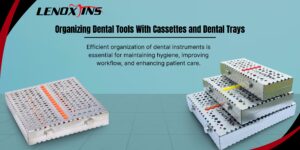Periosteal Elevator Mastery for Dental Procedure Success
- lenoxinstro
- November 15, 2024
- Dental Instruments, Dental Surgical

Have you ever found yourself struggling with the precision required to create a wide flap without damaging the periosteum in dental surgery? The periosteal elevator is a crucial tool for such a task, yet utilizing it effectively can be a challenge. This guide will walk you through the necessary preparations, provide a step-by-step process for handling the elevator correctly, and explore advanced techniques to refine your skill set. Understanding these methods ensures your stock of expertise will expand, directly benefiting patient outcomes. Stick with us to navigate common setbacks and enrich your dental practice with proficiency in using the periosteal elevator.
Understanding the Role of the Periosteal Elevator in Dental Surgery
In the landscape of dental surgery, the periosteal elevator emerges as a critical tool for effective treatment outcomes. This instrument, typically forged from durable stainless steel, is crucial for tasks like flap reflection, where surgical precision is paramount. The upcoming segments will delve into the various functions of the periosteal elevator, demystifying the importance of choosing the right type for specific procedures. We’ll explore how different designs interact with tissue and bone, and how their proper use can significantly enhance surgical success. With each section, we aim to equip practitioners with the knowledge to select and utilize these tools, reflecting a commitment to patient care and procedural excellence. Periosteal Elevators
Exploring the Functions of the Periosteal Elevator
The periosteal elevator serves as an invaluable retractor and a crucial surgical instrument for manipulating soft tissue during dental procedures. In the hands of a skilled practitioner, it carefully separates periosteal membrane from the bone, critical when gaining access to tooth roots or preparing a site for implants. Its precise application mitigates tissue damage, fostering a conducive environment for healing and recovery.
Within its varied roles, the periosteal elevator also assists in tooth extractions by easing the removal process. Successful usage of elevators demands an intimate understanding of their design and capabilities, which in turn reduces patient discomfort and expedites post-operative healing. Dental professionals rely on this instrument to navigate the delicate landscape of oral surgery, emphasizing its importance in the overall toolkit of periodontal care. periosteal elevator
Identifying Different Types of Periosteal Elevators
Distinguishing between various types of periosteal elevators is essential for dental professionals aiming to master surgical procedures. Each elevator is designed with a specific end goal in mind, whether it’s to delicately detach soft tissue or efficiently lift periosteal layers. Common types include the Woodson, which is double-ended, featuring a flat, rounded tip on one end for lifting, and a blunter, spatula-like tip for pressing down tissues. For those interested in exploring a vast selection of these essential instruments, periosteal elevators are available.
When selecting a periosteal elevator, attention to detail is paramount; the Molt periosteal elevator, for example, is favored for its narrow tip that allows for precise separation in tight spaces. Understanding the subtleties of instruments like the Molt can lead to improved outcomes in procedures such as implant site preparation, where minimizing tissue trauma is crucial for successful healing and integration.
Recognizing the Importance of Instrument Selection
Choosing the right periosteal elevator aligns closely with successful clinical outcomes in dental surgery. Each procedure has unique requirements and nuances, making the selection of an appropriate instrument not just a matter of preference, but a strategic decision that can influence healing times and patient experience. Dental professionals must consider the size, shape, and sharpness of the tool to suit the specifics of the surgical site, ensuring minimal trauma and optimal results.
Patient anatomy varies significantly, which has a direct impact on the effectiveness of periosteal elevators during procedures. A meticulous approach to selecting the correct elevator can facilitate easier access to tight spaces and reduce the risk of complications, such as damage to the periosteum or surrounding tissues. Dentists skilled in instrument selection are better prepared to handle unforeseen challenges during surgery, showcasing their commitment to excellence in patient care.
How Periosteal Elevators Aid in Flap Reflection
Flap reflection is a meticulous process that involves the careful elevation of gingival tissue to access the underlying bone and teeth structures. In this precise task, the periosteal elevator plays a key role by gently pushing back the soft tissue, minimizing trauma and setting the stage for successful dental procedures like implants or bone grafts. The tool’s design enables dental surgeons to create a clean and controlled field, crucial for both the operation’s success and the patient’s recovery time.
The effectiveness of flap reflection hinges on the periosteal elevator’s ability to discernibly separate the periosteum from the bone without inflicting undue damage. Dental professionals must skillfully navigate the fine line between force and finesse, employing this instrument to create adequate space for treatment while safeguarding the integrity of the tissue. Consequently, such expertise directly impacts the procedure’s efficacy, patient comfort, and the healing process, highlighting the periosteal elevator’s significance in dental surgery.
Enhancing Surgical Outcomes With Proper Use
The adept use of a periosteal elevator can significantly boost surgical outcomes, ensuring both the efficacy of the procedure and the wellbeing of the patient. When used correctly, the instrument enables surgeons to carefully maneuver tissues with minimal disruption, leading to a decrease in patient recovery time and an increase in overall procedural success. Dental professionals who master the application of the periosteal elevator demonstrate their dedication to patient health and surgery optimization.
Dental surgery’s complexity necessitates a keen understanding of instrument functionality, with the periosteal elevator being no exception. Optimal use of this tool not only aids in the precision of procedures such as flap reflection but also helps prevent the complications associated with tissue damage. The surgeon’s experience with the periosteal elevator is a critical factor that directly correlates with enhanced patient outcomes and reinforces the importance of proper technique in dental surgeries.
Preparing for Procedures With a Periosteal Elevator
As dental professionals embark on intricate surgical procedures, the periosteal elevator becomes instrumental in achieving precision and patient comfort. Preparation is key; ensuring proper sterilization and maintenance of the instrument is paramount for safety and efficacy. Establishing an efficient surgical field, selecting the appropriate periosteal elevator, and implementing precautionary measures all contribute to the safety and well-being of the patient. Additionally, mastering handling techniques can enhance the surgeon’s skill set, leading to more favorable outcomes. Our subsequent discussion will explore these topics, laying out a fundamental understanding of each step’s importance and best practices.
Ensuring Proper Sterilization and Maintenance
For dental professionals, the sterility of surgical instruments is non-negotiable. The periosteal elevator is no exception, requiring thorough sterilization to prevent the transmission of infectious agents. Maintenance of the tool also plays a significant role; sharpness and integrity must be routinely checked to ensure that the delicate balance between efficacy and tissue preservation is maintained during procedures. Proper care and sterilization protocols are integral to both patient safety and the longevity of the instrument itself.
Adherence to standardized sterilization practices, such as autoclaving, is vital for the preparation of periosteal elevators before each dental surgery. It is imperative that these tools undergo rigorous cleaning and sterilization to eliminate the risk of cross-contamination. By emphasizing the importance of these practices, dental surgeons reinforce their commitment to delivering safe, high-quality care, while extending the functional life of their surgical instruments, thereby optimizing their practices for successful patient outcomes. Periosteal elevators
Setting Up the Surgical Field Effectively
Effective setup of the surgical field is imperative for the success of dental procedures employing a periosteal elevator. The arrangement of instruments and materials should facilitate easy accessibility and maintain a sterile environment, preventing contamination risks. By prioritizing efficient organization, dental professionals can focus on precision work, knowing that everything they need is within reach and prepared under stringent aseptic conditions.
Attention to detail is crucial when creating an ideal surgical field, as it reflects on a dentist’s ability to conduct complex surgeries with confidence. A well-prepared workspace not only ensures the smooth flow of the procedure but also instills a sense of calm and preparedness, contributing to the patient’s comfort and trust. Thus, the careful setup of the surgical field directly correlates with the quality of periosteal elevator usage and overall surgical success.
Selecting the Right Periosteal Elevator for the Task
Selecting the appropriate periosteal elevator is fundamental to the efficacy of dental procedures. Dental practitioners must assess the specific requirements of the surgery, whether working within confined spaces or performing delicate tissue manipulations, to determine the right instrument. For instance, a periosteal elevator with a slender, pointed tip is preferred for intricate work around sensitive areas, ensuring precision without causing undue trauma to surrounding tissues.
It’s critical for a dentist to have a range of periosteal elevators to cover various surgical scenarios effectively. Factors like the tip’s sharpness, the handle’s ergonomics, and the instrument’s overall balance play a significant role in both the success of the procedure and the comfort of the patient. By choosing the most suitable periosteal elevator, practitioners can enhance patient outcomes and streamline the healing process, reflecting a deep understanding of the tools at their disposal.
Implementing Safety Measures for Patient Care
Ensuring patient safety is paramount when using a periosteal elevator in dental surgeries. Dental professionals must adopt rigorous safety protocols that encompass both pre-operative and post-operative care, mitigating any potential risks of infection or injury. By integrating a thorough review of the patients’ medical history and clearly communicating procedural steps, dentists can foster a secure and reassuring environment, alleviating concerns while upholding the highest standards of care.
Proactive measures such as proper instrument handling and maintaining a clear surgical field significantly contribute to patient well-being. Surgeons skilled in the use of periosteal elevators are vigilant in preventing inadvertent tissue trauma, emphasizing the instrument’s precise maneuvering to safeguard delicate oral structures. This meticulous approach not only advances the success of dental procedures but also exemplifies a deep commitment to patient-centric care, enhancing trust and satisfaction.
Mastering Instrument Handling Techniques
Mastering the handling techniques associated with the periosteal elevator is a critical component of dental surgery. Dental practitioners must intimately understand the instrument’s weight and balance to perform precise movements that minimize tissue trauma. The key to proficiency lies in consistent practice, which cultivates an instinctive sense of control during flap reflection procedures, directly influencing the quality of patient care and surgical results.
As dentists navigate through various dental surgeries, their ability to adeptly manipulate a periosteal elevator becomes a testament to their surgical skill. It’s essential for them to maintain a steady hand and gentle touch, ensuring that the elevator carefully detaches tissues without causing unnecessary damage. This fine motor control is not only central to safeguarding the patient’s oral health but also crucial in enhancing the healing process post-surgery.
Step-by-Step Guide to Using a Periosteal Elevator
Effective utilization of a periosteal elevator is pivotal for success in dental procedures. This step-by-step guide encompasses positioning the patient for optimal access, employing precise incision techniques for flap elevation, and meticulously reflecting soft tissue. Careful attention to avoiding tissue damage during elevation and securing the flap for unobstructed surgical access is also detailed, consolidating the periosteal elevator’s role in careful and successful dental surgeries.
Positioning the Patient and Accessing the Surgical Site
The initial phase of using a periosteal elevator hinges upon correctly positioning the patient to access the surgical site with ease. Dental surgeons must prioritize comfort and visibility, adjusting the dental chair to an angle that affords a clear view while ensuring the patient remains relaxed throughout the procedure. A well-positioned patient prevents strain on both the practitioner and the individual undergoing treatment, facilitating a smoother operation.
Accessing the surgical site with precision encompasses making an incision that allows for effective flap reflection used mainly in implantology or periodontal surgery. Surgeons must use the periosteal elevator with careful, measured movements to secure the necessary visibility of the bone or tooth root while respectfully treating the delicate surrounding tissues. Skill in creating and maintaining access is crucial, as it sets the stage for a successful procedure and a quick patient recovery.
Techniques for Initial Incision and Flap Elevation
The creation of an initial incision is pivotal for successful flap elevation using a periosteal elevator in dental surgeries. A surgeon must meticulously cut through the gingival tissue with precision, minimizing trauma to the tissue while establishing access to the underlying bone or tooth structure. The depth and angle of the incision are critical as they determine the ease with which the flap can be elevated and repositioned after the procedure.
Once the incision is made, the periosteal elevator is gently inserted between the tissue and bone, using careful, sweeping motions to reflect the flap. This action must be executed with finesse to prevent damage to the periosteum, which is vital for tissue reattachment and healing. Surgeons adept in these techniques ensure that the flap is adequately reflected to provide a clear surgical field, while preserving tissue integrity for patient comfort and quicker recovery.
Methods for Reflecting Soft Tissue Safely
Reflecting soft tissue with a periosteal elevator requires a technique that balances delicacy with firmness. The surgical professional must ensure that the instrument is cradled correctly to slide between the periosteum and the bone without excessive force. It’s critical to maintain the tissue‘s structural integrity, thereby reducing the risk of postoperative complications and enhancing the healing process.
To safeguard the patient’s well-being, the periosteal elevator must be manipulated with precise, controlled movements. Surgeons are trained to apply consistent lateral pressure as they gently peel the tissue back, an approach that preserves blood supply and mitigates inflammatory response. This technique, grounded in a clear understanding of tissue mechanics, is pivotal in maintaining the health of the soft tissue and ensuring it remains viable for reattachment.
Avoiding Tissue Damage During Elevation
Mitigating tissue damage during the elevation process is crucial for both the outcome of dental procedures and patient recovery. A dental surgeon must carefully manipulate the periosteal elevator, using a technique that combines gentle elevation with just enough traction to minimize strain on the soft tissues. This approach ensures the periosteum’s ability to reattach and heal post-operation, emphasizing the importance of skill and precision in dental surgical practices.
In dental surgery, each movement carries significant impact. Therefore, surgeons must be particularly vigilant when elevating tissue to avoid creating tears or undue stress that could lead to extended recovery times. The subtle motion of rolling the periosteal elevator in an upward direction, rather than using a forceful lift, can greatly reduce the risk of tissue damage. It is this level of meticulous care and technique that distinguishes competent dental professionals and contributes to their patients’ optimal healing.
Securing the Flap for Surgical Access
Securing the flap for surgical access is a delicate yet critical step within the use of a periosteal elevator. It entails repositioning the elevated tissue to provide unhindered visibility and reach to the surgical site. Dental professionals take great care in this phase, ensuring the flap remains stable and protected to maintain the sterile field, thus preventing contamination and facilitating a successful dental procedure.
The periosteal elevator‘s role extends to guaranteeing the flap does not obstruct the surgical area. Surgeons employ their expertise to delicately tuck or suture the tissue aside, keeping the site clear for the duration of the operation. This meticulous preparation allows the dental professional to proceed with precision, reducing operative time and enhancing patient comfort during the path to recovery. Periosteal elevators
Advanced Techniques With the Periosteal Elevator
Moving into more sophisticated applications, the periosteal elevator is at the heart of complex oral surgeries. Its role in intricate extractions, implantology, and bone grafting cannot be overstated. This subsection delves into the nuances of using the elevator alongside other dental instruments, adapting techniques to accommodate anatomical variations, and sharpening skills for advanced procedures. Each following segment offers practical insights into mastering these vital areas of dental practice.
Utilizing the Elevator in Complex Extractions
In the realm of oral surgery, complex extractions often require the delicate yet assertive use of a periosteal elevator. This instrument’s precision is instrumental in detaching the periodontal ligament and expanding the alveolar socket, enabling the removal of impacted or fractured teeth with minimal adjacent tissue damage. Dental surgeons rely on the finesse of the periosteal elevator to navigate these challenging extractions, thereby ensuring patient comfort and reducing recovery time.
The periosteal elevator‘s role is pivotal when confronting ankylosed teeth or roots nestled in dense bone. Surgeons adept in its use skillfully leverage the tool to create sufficient space around the tooth, allowing forceps to grasp and remove the tooth effectively. This approach circumvents the need for excessive force, protecting the integrity of the socket and surrounding bone, which is essential for future restorations or implants.
Application in Implant Surgery and Bone Grafting
In the precision-driven context of implant surgeries and bone grafting, the periosteal elevator is indispensable in preparing the bony ridge for receiving graft material or implants. Mastery in manipulating this tool allows dental surgeons to delicately lift the periosteum, creating a clean, controlled space for the placement of grafts or implants, consequently improving osseointegration and ensuring long-term stability.
The periosteal elevator‘s role extends to meticulously managing soft tissue, which is crucial in both pre-grafting to expose the recipient site and post-implant placement to secure the soft tissue flap. Its precise use minimizes the risk of peri-implantitis and other complications, thus providing a safer healing course and better outcomes for the patients receiving these advanced dental treatments. Periosteal Elevators
Integrating With Other Dental Instruments
Effective dental surgery often involves a choreographed use of multiple instruments, with the periosteal elevator playing a central role alongside dental forceps, chisels, and bone files. Seamlessly integrating the periosteal elevator with these instruments allows for a gradual, methodical transition during procedures, which is pivotal for maintaining tissue viability and achieving precise outcomes in procedures such as alveolar ridge preservation or socket repair post-extraction.
Dental surgeons must be adept at switching between the periosteal elevator and other tools like curettes and rongeurs without compromising the sterility of the field. This skill not only enhances the efficiency of the surgical process but also instills confidence in patients, knowing their oral care is facilitated by a professional versed in harmonizing an array of dental instruments for optimal results.
Adapting to Anatomical Variations
Adapting the use of a periosteal elevator to accommodate anatomical variations is crucial for dental surgeons. Each patient presents a unique oral landscape, which requires a tailored approach to surgical intervention. Surgeons must have a deep understanding of how different periosteal elevator designs interact with diverse bone topographies and soft tissue densities, ensuring delicate manipulations that respect the individual anatomy while aiming for optimal surgical outcomes.
Recognizing and adjusting to these variations can prevent common surgical pitfalls, increasing the likelihood of a successful procedure. By employing periosteal elevators with the flexibility to navigate varied contours and textures found within the mouth, surgeons can safeguard the structural integrity of both hard and soft tissues. This adaptability not only reflects a surgeon’s skill but also enhances patient comfort and contributes to quicker healing times post-surgery.
Refining Skills for Advanced Procedures
To fine-tune skills for advanced dental procedures, practitioners must engage in continuous education and hands-on practice with the periosteal elevator. Mastery in this area extends beyond textbook knowledge, as the surgeon’s tactile sensitivity and motor coordination are honed through experience, enhancing outcomes in complex surgeries like sinus lifts or ridge splitting. Surgeons dedicated to refining their techniques with the periosteal elevator exhibit improved proficiency that contributes directly to patient satisfaction and surgical excellence.
Within the realm of intricate dental surgeries, the periosteal elevator‘s role is magnified, requiring the dental professional to navigate the nuances of varying oral anatomies with confidence. Focused training modules and peer review sessions can provide critical feedback, enabling the dentist to adjust their approach to each unique surgical challenge. This level of commitment to skill enhancement ensures that patients receive the highest standard of care, minimizing recovery time and maximizing the long-term success of surgical interventions.
Troubleshooting Common Challenges
In mastering dental procedures with a periosteal elevator, practitioners may encounter several common challenges. Addressing complications during flap reflection requires precision and care, while recognizing and preventing instrument wear is essential for maintaining performance. Managing patient discomfort effectively is paramount for a positive clinical experience. Strategies for navigating difficult surgical scenarios enhance procedure success, and knowing when to employ alternative tools can be crucial. This subsection provides practical solutions for overcoming these obstacles and ensuring procedural excellence.
Addressing Complications During Flap Reflection
During flap reflection in dental procedures, complications may arise such as tears in the periosteum, which can adversely affect healing. Dental professionals should navigate these challenges with a nuanced understanding of tissue structure, gently maneuvering the periosteal elevator to minimize the risk of tearing and ensuring the creation of a clean, viable flap for subsequent reattachment.
In the event of bleeding or undue tissue resistance, the proficient use of the periosteal elevator becomes paramount in maintaining surgical visibility and preserving tissue integrity. Swift and skillful adjustments by the dental surgeon can mitigate these immediate concerns, facilitating continuous control over the procedure and promoting an environment conducive to successful patient outcomes.
Recognizing and Preventing Instrument Wear
Recognizing the signs of instrument wear in periosteal elevators is fundamental for dental surgeons to maintain precision in procedures. A worn elevator may lead to improper flap elevation and increased risk of tissue trauma, compromising the quality of dental surgeries. Surgeons should routinely inspect their instruments for signs of dullness, bending, or damage to the working ends, ensuring that their tools always perform at their best.
To prevent premature wear of periosteal elevators, proper care and handling are essential. Dental professionals are advised to follow strict cleaning protocols and storage guidelines, using specifically designed cases that secure instruments and safeguard their edges from accidental contact. Regular maintenance checks and professional sharpening can preserve the functionality of these critical tools, leading to safer, more effective surgical outcomes.
Managing Patient Discomfort Effectively
Managing patient discomfort effectively is a top priority during the use of a periosteal elevator in dental surgeries. Skilled dental surgeons minimize discomfort by applying local anesthesia accurately and using the periosteal elevator with a gentle touch to reduce tissue inflammation and soreness post-procedure. Utilizing these techniques ensures patients experience minimal pain, leading to a more comfortable recovery period.
The dental professional’s expertise in handling periosteal elevators goes a long way in alleviating patient anxiety and discomfort. By explaining the procedure in straightforward terms and demonstrating confident, careful maneuvers during tissue reflection, surgeons can ease patient concerns, resulting in a more relaxed surgical environment. Patient comfort is significantly enhanced when they are assured of the surgeon’s competence and sensitivity to their well-being.
Strategies for Difficult Surgical Scenarios
In the face of difficult surgical scenarios, dental surgeons must rely on their profound knowledge and dexterity with tools such as the periosteal elevator. Defining clear strategies can overcome complications, such as adapting to unpredictable variations in tissue density or bone structure. Surgeons equipped with a comprehensive understanding of various surgical techniques can swiftly recalibrate their approach, mitigating risks and enhancing patient recovery.
It is critical for dental professionals to maintain composure during challenging surgeries and to employ periosteal elevators with the utmost precision. Anticipating issues like excessive bleeding or unexpected anatomical hurdles allows for prompt and effective solutions, ensuring the operation progresses smoothly. The success of these complex procedures thus hinges on a surgeon’s ability to accurately gauge the situation and respond with the right periosteal elevator technique.
Knowing When to Use Alternative Tools
Knowing when to transition to alternative surgical instruments can be vital in dental procedures, particularly when a periosteal elevator may not offer the best outcome. For instance, dental surgeons might opt for a finer suture or a more specialized tissue retractor when encountering fragile tissues or working in confined spaces. Making these judicious instrument swaps can mitigate risks and foster better healing, demonstrating the importance of adaptable surgical strategies.
The proficiency of a dental professional is partly defined by their ability to discern the necessity for alternative tools in the midst of surgery. This aptitude ensures that they can maintain the integrity of the surgical procedure, even when faced with challenging tissue presentations. Transitioning to a dental probe or scissors may occasionally be prudent to achieve the precise dissection or meticulous tissue handling required for optimal results.
Continuing Excellence in Dental Practice
Excellence in dental practice hinges on a continuous commitment to learning and adapting. Staying abreast of the latest innovations in dental instruments, such as the periosteal elevator, is only the beginning. Dental practitioners must engage in constant training and education to refine their techniques and integrate constructive feedback into their practice. Beyond honing skills, it’s crucial to educate patients on surgical procedures, ensuring informed consent and clarity in expectations. Lastly, building and maintaining a comprehensive set of reliable surgical tools underpins the efficacy and safety of each procedure. The forthcoming sections will delve into these areas, offering insights on how they contribute to sustained professionalism and expertise in dental surgeries.
Staying Informed About Instrument Innovations
Remaining current with advancements in dental instrument technology, such as those related to the periosteal elevator, is vital for dental practitioners aspiring to deliver superior care. The introduction of novel features like ergonomic handles or advanced materials can dramatically affect the precision and comfort of dental surgeries. By keeping pace with these developments, dentists can improve their surgical technique, ensuring more predictable and favorable outcomes for their patients.
Engaging with professional networks, attending industry conferences, and subscribing to dental surgery publications are effective strategies for staying informed about the latest innovations in periosteal elevators and related tools. Incorporating these state-of-the-art instruments into their practice allows dental surgeons to operate at the forefront of periodontal care, enhancing both the patient experience and the efficiency of surgical procedures.
Participating in Ongoing Training and Education
Participation in ongoing training and education is essential for dental professionals seeking to excel in surgical proficiency with tools like the periosteal elevator. As dental techniques and technologies evolve, continuous learning ensures dentists are equipped with the latest skills and knowledge to perform intricate procedures effectively. Advanced workshops and specialized courses offer hands-on experiences that deepen their understanding of periosteal elevator utilization, significantly enhancing patient care and surgical outcomes.
Engagement in regular continuing education also allows dental practitioners to exchange insights with peers, fostering a community of shared expertise. These collaborations often result in the dissemination of best practices across the field, ultimately leading to improved procedural techniques and a refinement of periosteal elevator handling. This commitment not only supports a dentist’s personal development but also upholds the industry’s standards for excellence and patient safety.
Incorporating Feedback to Improve Techniques
Incorporating feedback is an indispensable part of refining surgical techniques with a periosteal elevator. Dental practitioners benefit from listening to patient experiences post-surgery, which can highlight areas for improvement in handling the tool or in the overall surgical approach. Constructive criticism from peers and mentors also plays a crucial role in enhancing technique, providing actionable insights for more precise tissue handling and flap reflection.
Continuous improvement in periosteal elevator utilization is driven by the integration of patient feedback and clinical outcomes into practice. When dental professionals actively seek and apply feedback, they not only elevate their surgical proficiency but also contribute to advancements in dental surgery. This proactive adaptation ensures better patient experiences, reduced recovery times, and more successful surgical outcomes, solidifying the practitioner’s reputation for excellence in periodontal care.
Educating Patients on Surgical Procedures
Educating patients on surgical procedures is a pivotal aspect of dental practice that enhances patient trust and compliance. Dental professionals who adeptly explain the use of a periosteal elevator, the steps involved in flap reflection, and anticipated outcomes foster a transparent and reassuring environment. This educational approach demystifies the surgical process, allowing patients to engage in informed decision-making and set realistic expectations for recovery and results.
When dental surgeons take the time to break down complex procedures into understandable segments, they not only address patient concerns but also empower them with knowledge. A thorough explanation of how a periosteal elevator facilitates dental surgery, including potential postoperative sensations and care, can alleviate apprehension. This emphasis on patient education underscores the dentist’s dedication to comprehensive care and can markedly improve the patient experience.
Building a Reliable Set of Surgical Instruments
A comprehensive set of high-quality surgical instruments is the cornerstone of any successful dental practice, with each tool, including the periosteal elevator, playing a pivotal role in various dental procedures. By ensuring their toolkit is equipped with well-crafted, reliable instruments that are kept in an impeccably maintained condition, dental professionals can perform complex surgeries with greater accuracy and confidence, ultimately leading to improved patient outcomes.
Investing in a set of surgical instruments that meet the highest standards not only facilitates excellence in practice but also conveys a message of dedication to patient care. Dental surgeons must select tools that offer precision and ergonomics, allowing for better control and less fatigue during procedures. This careful curation of surgical implements ensures readiness for a wide array of dental challenges, contributing to a practice’s reputation for quality care.
Conclusion
Mastering the use of a periosteal elevator is paramount for dental surgeons to perform procedures with precision and ensure patient well-being. The right choice of instrument and technique can significantly minimize tissue trauma, improving recovery times and surgical outcomes. Continuous learning and attention to instrument care are crucial for maintaining expertise in this vital aspect of dental surgery. Thus, a periosteal elevator is not just a tool but an extension of the surgeon’s skill, reflecting their dedication to excellence in patient care.





